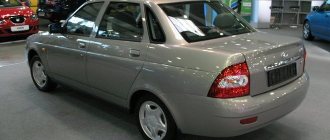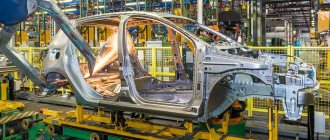OJSC AvtoVAZ (former name Volzhsky Automobile Plant) is a large company owned by the Renault-Nissan alliance. The plant produces cars under the Datsun, Nissan, Renault and LADA . Thanks to high-tech equipment, it produces about 1 million copies per year. The production volume is almost 470,000 units, and the number of cars produced is about 18% of the Russian market .
Previously, the company produced Samara, Niva, Lada and Sputnik cars.
History of the plant's creation
In 1960, the Soviet Union lacked the technology to produce high-quality vehicles. Fiat took part in the design . After 6 years, the contract was signed by A. Tarasov, the Minister of Automotive Industry. D. Agnelli (head of Fiat) took all necessary measures to organize production in Tolyatti. The use of original ideas and the best equipment of that time was of great importance.
Shock Komsomol construction began in the winter of 1967 . Companies from Germany, France, the United States of America and Great Britain took part in the large-scale project.
After the Soviet Union collapsed, efforts were made to create the AVVA . It was assumed that the All-Russian Automobile Alliance would work under the control and leadership of B. Berezovsky.
In 2000, a war began over the plant. Five thousand people died in the showdown - police officers, businessmen, plant managers, journalists, bandits and even public figures.
After 8 years, Renault bought a quarter of the shares of AvtoVAZ. FSUE Okhrana and SOK groups were involved in protecting the plant, which eliminated the possibility of any disagreements between the owners of the enterprise and third parties who would like to become co-owners.
During the period 2008-2009, an economic crisis occurred , which led to problems with exports and sales in Russia. The plant owed suppliers about 14 billion rubles. Production decreased by almost 50%. To solve this problem, the Russian Government allocated 25 billion rubles to AvtoVAZ. interest-free loan for up to 12 months. To help, a special program was created at the state level, which involved issuing car loans for cars in order to increase sales.
In early autumn 2009, in order to improve the financial position of the company, the company massively laid off staff. The crisis caused a decline in the quality of manufactured cars. A year later, the “LADA Quality” program came into force, which was aimed at producing exceptionally high-quality products. The measures taken for modernization yielded significant results - the quality of cars improved 10 times after just 3 years. Production growth is planned to increase to 1.2 million vehicles per year, as indicated in the business plan, which is valid until 2022.
JSC "AVTOVAZ"
Contacts
Address: 445024, Russia, Samara region, Togliatti, Yuzhnoe highway, 36 Tel./fax: 8-800-200-52-32 Official website: https://www.lada.ru
About the company
The company was founded in 1966.
JSC AVTOVAZ (Volzhsky Automobile Plant) is a Russian automobile manufacturing company, the largest manufacturer of passenger cars in Russia and Eastern Europe. The plant is focused mainly on the domestic market for its products.
Manufactured products
LADA Granta
- LADA Granta sedan
- LADA Granta liftback
- LADA Granta Sport
LADA Kalina
- LADA Kalina hatchback
- LADA Kalina station wagon
LADA Priora
- LADA Priora sedan
- LADA Priora station wagon
- LADA Priora hatchback
- LADA Priora Coupe
LADA Largus
- LADA Largus station wagon 5 seats
- LADA Largus station wagon 7 seats
- LADA Largus van
LADA 4×4
- LADA 4×4 3 doors
- LADA 4×4 5 doors
Discontinued products
- VAZ-2101
- VAZ-2102
- VAZ-2103
- VAZ-2104
- VAZ-2105
- VAZ-2106
- VAZ-2107
History of the enterprise
July 20, 1966. The Central Committee of the CPSU and the Soviet government decided to build a new large automobile plant in the city of Tolyatti. The preparation of the technical project was entrusted to the Italian automobile concern Fiat.
January 3, 1967. The Komsomol Central Committee declared the construction of the Volga Automobile Plant an All-Union Komsomol shock construction project. Already on January 21, 1967, the first cubic meter of earth was removed for the construction of the first workshop of the plant - the building of auxiliary workshops (ACS).
1969 Work collectives of the plant are being formed. The installation of production equipment produced at 844 domestic factories, 900 factories of the socialist community, by companies from Italy, Germany, France, England, the USA and other countries continued.
April 19, 1970. The first six VAZ-2101 Zhiguli cars rolled off the main assembly line of the plant; their design was basically the same as the Italian model FIAT-124, but assembled entirely from localized components.
October 28, 1970. The first train with Zhiguli cars was sent to Moscow.
July 16, 1971. The 100,000th car bearing the VAZ brand was produced.
January 10, 1972. The State Commission signed an act on the acceptance into operation of the second stage of the Volzhsky Automobile Plant with a capacity of 220 thousand cars per year. The plant was officially accepted by the State Commission on December 22, 1973 .
Links:
- Official website of JSC AVTOVAZ
See also:
- Automotive factories
- Mechanical engineering enterprises
- Industrial enterprises of Tolyatti
- Industrial enterprises of the Samara region
We would be grateful if you put a link to this page on your website. Link code:
| Information about JSC AVTOVAZ (Volzhsky Automobile Plant) |
Information updated June 29, 2014
First models
In 1970 Zhiguli VAZ-2101 cars were produced . They were designed based on Fiat. In neighboring countries they were known as “LADA”. Only high-quality Soviet components were used in production. This significantly increased the performance characteristics of the finished models.
The first cars were low-powered:
- The engine had a volume of 1.2 liters.
- Power – only 62 horsepower.
- The maximum speed could be reached up to 140 km/h.
Gradually, measures were taken to strengthen the suspension, body and increase ground clearance. This car model was produced until 1988 . In total, almost 5 million units were sold. Next, a whole family of VAZs was released, which were a modification of the sedan.
Without the involvement of third parties, the second model was designed: a 5-door station wagon - VAZ-2102, and VAZ-2103 (the prototype of the Fiat Special 124). Among the most popular models, the VAZ-2106, released in 1976, should be highlighted.
Key companies
The AVTOVAZ Group is part of the Renault-Nissan-Mitsubishi Alliance and produces full-cycle vehicles and auto components for four brands: LADA, Renault, Nissan, Datsun.
The President of AVTOVAZ is Yves Karakatzanis.
history of the company
On July 20, 1966, the USSR government issued a decree on the construction of a plant in the city of Tolyatti to produce 600 thousand passenger cars per year. This date is considered the birthday of the Volzhsky Automobile Plant.
The Volzhsky Automobile Plant was built in record time: construction began in 1967, and in 1970 the first products appeared - VAZ-2101 cars, which laid the foundation for the widely known and popular LADA brand today.
Chronology:
1966 - a government decree was adopted on the construction of an automobile plant in the city of Togliatti. V.N. was appointed general director of the passenger car plant under construction. Polyakov
1970 – production of VAZ-2101 cars began
1977 – the first LADA 4×4 car (VAZ-2121 Niva) was assembled
1984 – production of cars of the LADA Samara family began. The era of front-wheel drive models has begun in the history of LADA
1986 - the government of the USSR decided to create an industrial scientific and technical center in the AVTOVAZ association
1993 – open joint stock company AVTOVAZ was formed
1996 – serial production of LADA 110 started
2004 – production of a new family of cars began – LADA Kalina
2007 – release of a new flagship in the car line – LADA Priora
2008 – a strategic partnership agreement was signed with Renault
2011 – production of LADA Granta began
2012 – the first LADA car built on the Renault-Nissan Alliance platform was released – LADA Largus
2015 – sales of the new generation LADA car started – LADA Vesta
2016 – sales of the compact urban crossover LADA XRAY started
2017 - expansion of the Vesta family: for the first time in the history of the brand, serial production of a dual-fuel vehicle was launched - LADA Vesta CNG. Sales of new cars LADA Vesta SW and LADA Vesta SW Cross have started
2018 – sales of LADA Vesta Cross sedan, LADA XRAY Cross and the new LADA Granta family started
Company today
AVTOVAZ is a unique enterprise; it is the largest manufacturer of the Renault-Nissan-Mitsubishi Alliance in Russia. The plant in Tolyatti is one of the largest automobile plants in the world and the only one in the Alliance that produces full-cycle cars and auto components for four brands (LADA, Renault, Nissan and Datsun).
The LADA model range is represented by five families of cars.
Products
- LADA Vesta (sedan, produced since 2015, since 2022 LADA Vesta CNG (bi-fuel modification of the sedan), LADA Vesta SW, LADA Vesta SW Cross have been produced, since 2022 LADA Vesta Cross has been produced)
- LADA XRAY (compact crossover - produced since 2015, LADA XRAY Cross produced since 2018)
- LADA Largus (five- and seven-seater station wagon, van - produced since 2012, LADA Largus Cross - since 2015)
- LADA Granta (the new family will be produced from 2022 and is available in sedan, hatchback, station wagon and liftback bodies)
- LADA 4x4 (three-door station wagon in production since 1977, restyling 1993, modernization 2009, 2013, five-door station wagon in production since 1995, LADA 4x4 Urban - since 2014)
All LADA cars comply with international environmental standards Euro-5, and those exported to EU countries comply with Euro-6.
Developments and innovations
According to the medium-term development plan, by 2026 the company plans to release eight new and facelift nine LADA models.
Holding composition
The Group's production facilities are located in Togliatti - JSC AVTOVAZ and in Izhevsk - LLC LADA Izhevsk.
Website: https://lada.ru
Start of export
The name "LADA" appeared only in 1971 . These Soviet cars were intended for consumers living in other countries. “Zhiguli” became popular in Iceland, Norway and Hungary. They were in great demand in Sweden and Finland. Exports were carried out in large quantities to Canada and Latin America. Soviet-made cars could be found in Australia, Africa and Asia. Exports of Zhiguli cars amounted to 60% of the profits brought by domestic mechanical engineering .
Production of the first all-wheel drive model
Despite all the efforts made, it was possible to create an all-wheel drive vehicle only in the late 70s. It was a Niva VAZ 2121 . The idea was born thanks to A. Kosygin, who instructed us to create a high-quality car that could be used in rural areas. Three organizations took part in the case - Volzhsky Automobile. AvtoVAZ managed to gain superiority in this matter.
The Niva SUV has become a legend not only in the Soviet Union, but also in neighboring countries.
Among the features of a small class car are:
- Three-door and five-door variations.
- Availability of a gasoline engine (capacity – 1.7 l).
- All-wheel drive, comfortable interior and independent suspension.
- Excellent performance in adverse conditions.
Production was carried out in full compliance with the legislation of the country. The models that were produced fully complied with established safety and quality standards.
New models of the 2000s
Since the beginning of the 21st century, AvtoVAZ has produced the Kalina family. The new family of cars has become a real legend. because it had a lot of advantages over previous models. This is due to the discovery of new technological capabilities that have only become available since 2000.
At the beginning of 2007, the Lada Priora was released - a modernized version of the ten. At the end of 2011, there was such an event as the replacement of the expensive Kalina model with a cheaper Granta. A year later, the Lada Largus, which was designed on the basis of the Renault Logan, entered the assembly line.
Every model released after the 2000s is equipped with gasoline engines. They fully comply with established environmental standards and the Legislation of the Russian Federation. This approach significantly increases the level of confidence in.
History of AvtoVAZ, years of production of VAZ models
“Lada is the key to Russian roads”
- this is exactly what the motto sounds like - this is the largest Russian company in the automotive industry. Also, this company is the largest manufacturer of passenger vehicles in Eastern Europe. Relatively recently, a controlling stake in this company passed into the hands of the Renault-Nissan alliance, which gave a new round of development to AvtoVAZ.
Today, the official name of the company is AvtoVAZ Open Joint Stock Company, but this was not always the case. In the period from 1966 to 1971, the company was called the Volzhsky Automobile Plant, and from 1971 until joining the Renault-Nissan alliance, it was called the Volzhsky Association for the Production of Passenger Cars "AvtoVAZ".
In addition to changing names, the history of AvtoVAZ is rich in many other interesting events. The most interesting of them were the releases and closures of car production. In this article, we will look at the production years of VAZ models that were developed and produced both by the company itself and in partnership with other automobile manufacturers.
Model range and years of production of each car
Over the years of its work under different names, AvtoVAZ managed to produce several dozen car models. Below you will find the production years of VAZ models that have ever rolled off the assembly line of this plant. 1. Zhiguli 2101
. These cars were produced from 1970 to 1988.
2. Zhiguli 2102
. These cars were produced from 1972 to 1985.
3. Zhiguli 2103
. These cars were produced from 1972 to 1984.
4. Lada/Lada 2104
. These cars were produced from 1984 to 2012.
5. Zhiguli/Lada 2015
. These cars were produced from 1980 to 2010.
6. Lada 2106
. These cars were produced from 1976 to 2004.
7. Lada/Lada 2107
. These cars were produced from 1982 to 2012.
8. Lada Sputnik/Samara I 2108
. These cars were produced from 1984 to 2003.
9. Lada Sputnik/Samara I 2109
. These cars were produced from 1987 to 2004.
10. Lada Sputnik/Samara I 21099
. These cars were produced from 1990 to 2004.
11. Lada 110
. These cars were produced from 1996 to 2007.
12. Lada 111
. These cars were produced from 1998 to 2009.
13. Lada 112
. These cars were produced from 1999 to 2008.
14. Lada Samara II 2113
. These cars were produced from 2005 to 2014.
15. Lada Samara II 2114
. These cars were produced from 2001 to 2014.
16. Lada Samara II 2115
. These cars were produced from 1997 to 2012.
17. Oka 1111
. These cars were produced from 1988 to 1994.
18. Lada Kalina I 1117
. These cars were produced from 2007 to 2013.
19. Lada Kalina I 1118
. These cars were produced from 2004 to 2012.
20. Lada Kalina I 1119
. These cars were produced from 2006 to 2013.
21. Lada Kalina I 11198
. These cars were produced from 2008 to 2013.
22. Lada EL Lada
. These cars have been produced since 2013.
23. Lada Kalina II 2194
. These cars have been produced since 2013.
24. Lada Kalina II 2192
. These cars are produced in 2013.
25. Lada Priora 2170
. The production years of VAZ Priora models begin in 2007.
26. Lada Priora 2171
. These cars have been produced since 2009.
27. Lada Priora 2172
. These cars have been produced since 2008.
28. Lada Priora 21728
. These cars have been produced since 2010.
29. Lada Priora 21708
. These cars have been produced since 2009.
30. Lada Nadezhda 2120
. These cars were produced from 1998 to 2007.
31. Lada/Lada Niva 2121
. These cars have been produced since 1977.
32. Lada/Lada Niva
2131. These cars have been produced since 1993.
33. Lada/Lada Niva II 2123
. These cars were produced from 1998 to 2002.
34. Chevrolet Niva
. These cars have been produced since 2002.
35. Lada Granta 2190
. These cars have been produced since 2011.
36. Lada Granta hatchback
. These cars have been produced since 2014.
37. Lada Largus
. These cars have been produced since 2011.
HISTORY OF AVTOVAZ
For the first time, people started talking about the need to build a new modern automobile plant in the USSR in 1966; it was in this year that the history of AvtoVAZ began. At the next congress of the CPSU Central Committee, which took place on July 20, it was approved that a new production facility would be built in the city of Tolyatti, which would produce the most modern cars. In order for these cars to be competitive on the world market, to provide technical equipment and personnel training, the Soviet government decided to involve the Italian automobile concern Fiat, which was friendly in those years.
The new plant began operating in 1969, and it was then that its first labor teams were formed. The first cars rolled off the assembly line a year later. These were VAZ 2101 cars, which were designed on the basis of the Italian FIAT-124 car. Below, we will tell you more about this and many other cars that have ever rolled off the AvtoVAZ assembly line.
VAZ 2101
This is a four-door sedan, which, as we said above, was built on the basis of the Fiat 124. To adapt to Soviet roads, the car underwent more than 800 changes. So, it was equipped with a larger carburetor engine - 1200 cubic centimeters, plus, the car received a higher ground clearance, and its body and wheel system were strengthened.
A little later, on the basis of this car, the so-called series of classic cars was released: VAZ 21011, which received an even larger engine - 1.3 liters, 21013 - an analogue of 21011, but with an engine from the VAZ 2101, as well as a special model for the needs of the police: car VAZ 2101-34, which was equipped with the most powerful engine in this family.
VAZ 2102
The history of AvtoVAZ and its cooperation with the Italian concern Fiat did not stop with the VAZ 2101 model; just a year after the appearance of this car on the market, a new car appeared: the VAZ 2102, which was a licensed version of the Fiat 124 Familiare.
The main improvement, compared to the VAZ 2101, was the trunk, which was located at floor level. This was done in order to facilitate loading and unloading procedures. Unfortunately, due to this modification, the car had a serious drawback: a weak level of sealing of the interior on the side of the rear door, which caused dust to enter the interior, as well as vapors that came out of the neck of the gas tank.
Another problem with the modification was the increased weight of the car, which required making the shock absorbers and suspension more rigid. This, of course, made it possible to maintain an acceptable carrying capacity: up to 250 kilograms with 2 passengers and up to 55 kilograms with five passengers, but made the car very rigid when driving.
In 1978, a special model was released: VAZ 21021, which was intended for export. The engine, which was taken from the VAZ 21011 model, as well as the rear luggage window, which was equipped with a washer and wipers, underwent changes.
Later, over the course of five years, the car was constantly modernized, but did not change its name. It was equipped with a more reliable ignition system, an even more powerful engine, and other, less significant adjustments were made, but all this could no longer save the car and in 1985 it was discontinued.
VAZ 2103
The VAZ 2103 car is a modified version of the VAZ 2101, which was based on the same Fiat 124. It appeared on the market in 1972. The main differences were a more powerful engine: 72 horsepower, and a more spacious interior: the headroom of passengers and the driver was increased by 15 millimeters. Also, it should be noted that the VAZ 2103 became the first domestic car to have a vacuum brake booster installed, as well as a “sports” panel.
In 1980, this car was equipped with a new carburetor, which made the VAZ 2103 more reliable, but just as in the case of the VAZ 2102, the innovations did not save the model. In 1984 it was discontinued.
VAZ 2104
The history of AvtoVAZ as the official manufacturer of station wagons began with the VAZ 2104. This car was released to replace the VAZ 2102 and was designed to absorb all the best from this car, but leave all its identified shortcomings in the past. For the first time, this car was released in 1984 and was produced until 2012. During this huge life span for a car, a lot of modifications of this car appeared on the market:
VAZ 21041 is a special, cheaper version, with a smaller engine.
VAZ 21042 - this modification was released specifically for countries with right-hand traffic
VAZ 21043 – updated, more modern interior and new five-speed gearbox.
VAZ 21044 - updated, larger engine - 1700 cubic centimeters.
VAZ 21045 - updated, larger engine - 1800 cubic centimeters.
VAZ 21045D is an analogue of the VAZ 21044, but with a diesel engine.
VAZ 21047 is an export version of this model.
VAZ 21048 is an analogue of the VAZ 21045, but with a diesel engine.
VAZ 21041 is the first and only modification of this car with an injection engine, which had a volume of 1.7 liters.
VAZ 2105
The VAZ 2105 car was the basis of the export line of AvtoVAZ cars. His design was based on the fashion of the 80s in Europe, but he also found good popularity in his native country. During the entire production of this car, it, like many other cars of that time, underwent many changes, which became more and more new modifications, but by and large, only one was serious, which took place in the early 2000s, when at VAZ 2105 began to install injection engines.
Another interesting fact about this car that is worth mentioning is that the VAZ 2105 is the first car in the history of AvtoVAZ, which began to have configurations, and was not produced in just one version.
VAZ 2106
The VAZ 2106 car is a more modern version of the VAZ 2103. It had a more pleasant design for those years, as well as a more powerful engine, which was comparable to the engines that were installed on later versions of the VAZ 2103.
Like previous AvtoVAZ models, the Six received many modifications during its life, but the VAZ 21067 became truly interesting, when the plant first produced a car that complied with European environmental standards. At that time it was the Euro 2 standard.
VAZ 2107
This car became the first AvtoVAZ car to run on gasoline higher than AI-76. Another interesting point was the fact that for the first time the special services turned to the plant for the car. A special modification of the VAZ 21079 was produced for them, which was equipped with an engine of 140 horsepower.
And of course, one cannot help but mention the fact that the VAZ 2107 is the first VAZ car to have a mono-injection system installed, albeit for an export modification.
VAZ 2108
The VAZ 2108 is the first car in the history of AvtoVAZ with front-wheel drive. Initially, the car had a bunch of shortcomings (many attribute this to a body that was unusual for designers: a three-door hatchback), which is why it enjoyed little popularity on the market, but after a couple of years, most of them were corrected, and consumers were presented with three trim levels: “Standard”, “Norma” and “Lux”, and also equipped the car with a more powerful engine, which breathed new life into the car, which lasted until 2003.
VAZ 2109
The VAZ 2109 is a five-door hatchback with front-wheel drive. It was produced at AvtoVAZ from 1987 to 2004, and after that, with a larger 1.6-liter engine, it continued to be produced in Ukraine for the domestic market. Like other AvtoVAZ cars, many modifications of this car were produced, but no critical changes occurred, even the replacement of a carburetor engine with an injection engine became typical for its time.
VAZ 21099
The VAZ 21099 car is the same VAZ 2109, but with a rear overhang increased by 200 millimeters. Even the modifications for these cars were similar. The only serious difference was the more sophisticated and up-to-date security system of the VAZ 21099, which was the best among domestic cars of that time.
VAZ 2110
The VAZ 2110 car was presented to management and the general public five times. The first four times it did not receive approval, as it looked either faceless or strongly resembled cars from other manufacturers, which would have made it difficult to enter foreign markets. Only after specialists from Porsche were involved in the design development in 1988 did the designers manage to create a car that eventually went into production and replaced the VAZ 2106 line, which by that time was obsolete.
Over the years, this car has undergone major changes to the engine and exhaust system several times. This was due to the fact that it sold well for export, but it was necessary to strictly comply with environmental standards that were often changing in those years. Thus, “tens” were released that corresponded to Euro 2, Euro 3, and even Euro 4.
VAZ 2111
This is a family station wagon that was launched on the market to successively replace the VAZ 2104, but was never really able to achieve the desired result. At the same time, under the export name Lada 111, it found considerable popularity among foreign buyers. It was all about the very large trunk, which, depending on the position of the rear seats, had a volume of from 490 to 1420 liters.
Like other cars that AvtoVAZ knows in history, it has gone through a long life, during which more than a dozen modifications of the VAZ 2111 were produced.
VAZ 2113
The VAZ 2113 car became the successor to the AvtoVAZ line of small cars with front-wheel drive in the back of a three-door hatchback. The decision to resume production of such cars was made under pressure from consumers who wanted to see an analogue of the VAZ 2108 on the market.
The car was equipped with a 1.5-liter engine, and it immediately complied with the Euro 2 standard, and later it was modified and began to comply with the Euro 3 standard.
VAZ 2114
The VAZ 2114 car is a decision that was made immediately after the VAZ 2113 cars were delivered to the assembly line. In fact, the VAZ 2114 replaced the VAZ 2109 cars, which were very popular at one time, on the market.
To the surprise of many AvtoVAZ fans, this car has received only one modification over the years of its existence, and the difference from the basic version was only in the larger engine.
VAZ 2115
The VAZ 2115 car is a four-door sedan with front-wheel drive, which was put into production as the market successor to the previously very popular VAZ 21099 car. The designers released two modifications of the VAZ 2115, but unlike previous years, they did not change the name of the car in any way, and also, instead of strengthening the engine, they experimented with installing smaller engines. So, they first tried to supply a 1.1 liter engine, and when the idea failed - 1.3 liters, but this option did not gain popularity and the plant was forced to return to the original 1.5 liter engine.
VAZ 2112
The VAZ 2112 car is, in fact, a VAZ 2110 in a hatchback body. The car was very popular at the time due to its attractive appearance and low price. These same factors made its export modification Lada 112 popular in the foreign market.
After the success of the five-door version, the three-door VAZ 2112 Coupe was released, but it did not become popular, which is most likely due to the fact that fans of three-door domestic cars had already gotten used to the VAZ 2108 and VAZ 2113.
Lada Kalina
The Lada Kalina went on sale in 2006. The car was produced in sedan and hatchback body styles, and a little later a station wagon body appeared. In 2007, the car was modified, it began to comply with the Euro 3 standard, and also became more economical.
For the first time in the history of AvtoVAZ, the plant's designers developed a special version of the car - the Lada Kalina GTI, which was intended for lovers of high-speed and dynamic driving. The car was much more maneuverable than the base model, and also had better dynamics, but it clearly did not reach the GTI class of other manufacturers.
Lada Priora
The Lada Priora is currently one of the most popular cars in the AvtoVAZ family. For the first time in history, AvtoVAZ received a car that even picky automobile magazines called good for its time.
This car is available in sedan, station wagon, three-wheel hatchback and five-door hatchback body styles.
VAZ 2121 and VAZ 2131 Niva
Cars of the Niva series are the only SUVs that AvtoVAZ produces independently. They are popular both among domestic consumers and among foreign buyers. Undoubtedly, this car has a minimum of comfort, but on the other hand, it shows excellent cross-country ability, and combined with its low price, it becomes the only representative of the segment of truly budget SUVs.
The difference between VAZ 2121 and VAZ 2131 is that the first car is three-door, and the second is five-door.
Chevrolet NIVA
The Chevrolet Niva is a modified VAZ 2131, which is assembled in a more modern body and adapted to urban conditions. This car is more comfortable than the classic Niva, but less passable.
Lada Granta
The Lada Granta is a car that is built on the platform of the Renault Logan, a very popular car in our country. This car is the most budget-friendly car currently produced by AvtoVAZ and is almost the most popular model in the history of AvtoVAZ.
Lada Largus
The Lada Largus car is a car that replaced the once-produced VAZ 2102, later the VAZ 2104, and even later the VAZ 2111. But unlike the previous station wagons, this car received a family seven-seater modification, as well as a “van” modification that was being developed especially for the commercial segment.
Strategic partnerships with foreign automakers
In the winter of 2008, the Volzhsky Automobile Plant and Renault became strategic partners, which significantly increased productivity. became the owner of a quarter of the shares. After 2 years, Nissan joined them. Together they put a lot of effort into reconstructing the platform in the main assembly shop at the Tolyatti plant. This stage became very significant, as it allowed the company to move to a higher level of automotive production.
Joint activities with foreign companies benefited AvtoVAZ. The plant began to use international standards. Employees of foreign companies also benefited from cooperation - they adopted the experience of masters of the Russian market. Through joint efforts it was possible not only to restore order in the assembly shop, but also to create a real sensation in the field of mechanical engineering.
History of AvtoVAZ in old photographs
On July 20, 1966, after analyzing 54 different construction sites, the CPSU Central Committee and the Soviet government decided to build a new large automobile plant in the city of Tolyatti. The preparation of the technical project was entrusted to the Italian automobile concern Fiat. On August 15, 1966, in Moscow, the head of FIAT, Gianni Agnelli, signed a contract with the USSR Minister of Automotive Industry, Alexander Tarasov, to create an automobile plant in the city of Tolyatti with a full production cycle.
On January 3, 1967, the Komsomol Central Committee declared the construction of the Volzhsky Automobile Plant an All-Union Komsomol shock construction project. Thousands of people, mostly young people, headed to Togliatti for the construction of the auto giant. Already on January 21, 1967, the first cubic meter of earth was removed for the construction of the first workshop of the plant - the building of auxiliary workshops (ACS). Since 1969, labor collectives of the plant began to form, most of them were the people who built the plant. The installation of production equipment produced at 844 domestic factories, 900 factories of the socialist community, by companies from Italy, Germany, France, England, the USA and other countries continued.
On March 1, 1970, the first 10 bodies of future cars were produced by the welding shop, and on April 19, 1970, the first six VAZ-2101 Zhiguli cars rolled off the main assembly line of the plant, the design basically repeating the Italian model FIAT-124, but assembled almost completely from localized components. Interestingly, on April 15, 1970, Henry Ford Jr. visited the Volzhsky Automobile Plant. On October 28, 1970, the first train with Zhiguli cars was sent to Moscow. With an estimated construction period of 6 years, the plant was put into operation 3 years earlier, which allowed the USSR to save more than 1 billion Soviet rubles.
On March 24, 1971, the State Commission commissioned the first stage of the Volzhsky Automobile Plant, which will produce 220 thousand cars per year. On July 16, 1971, the 100,000th car with the VAZ brand was produced. On January 10, 1972, the State Commission signed an act on the acceptance into operation of the second stage of the Volzhsky Automobile Plant with a capacity of 220 thousand cars per year. The plant was officially accepted by the State Commission with an “excellent” rating on December 22, 1973 - after the production of the millionth car; By decree of the Presidium of the USSR Supreme Soviet, the Volzhsky Automobile Plant was awarded the Order of the Red Banner of Labor. In 1977, the USSR State Prize in the field of literature, art and architecture was awarded for the architecture of the Volzhsky Automobile Plant complex. The plant's design capacity is 660 thousand cars per year. As of February 1, 2012, the plant's design capacity was 900 thousand cars per year.
See also: AvtoVAZ experimental cars
Tolyatti in old photographs
Photo album from Stavropol to Tolyatti
The photographs were posted by Togliatti photographer Vadim Kondratyev “The history of AvtoVAZ in old photographs”
New promising developments
It was AvtoVAZ that was the first among the enterprises of the Soviet Union, where even in those days a logic bomb was “planted” - the so-called computer program. This caused the assembly line to stop and served as the beginning of the workshop redesign stage. Through joint efforts, it was possible to install high-tech equipment, thanks to which production capabilities have increased.
Employees who worked for more than 20 years received the title of “VAZ Veteran” and were given a certificate. On the fifteenth anniversary of the technical center, they opened a museum in which they collected a whole fleet of cars, where you can see unique exhibits. Anyone can visit the establishment and see what cars were produced at the plant, how their appearance and operational capabilities changed over time.
Today, the former Volzhsky Automobile Plant is a giant in the production of Russian automotive equipment. Despite the fact that many models have long been discontinued, they continue to be repurchased and used. The long service life is due to the highest quality of components and the work of true professionals.











